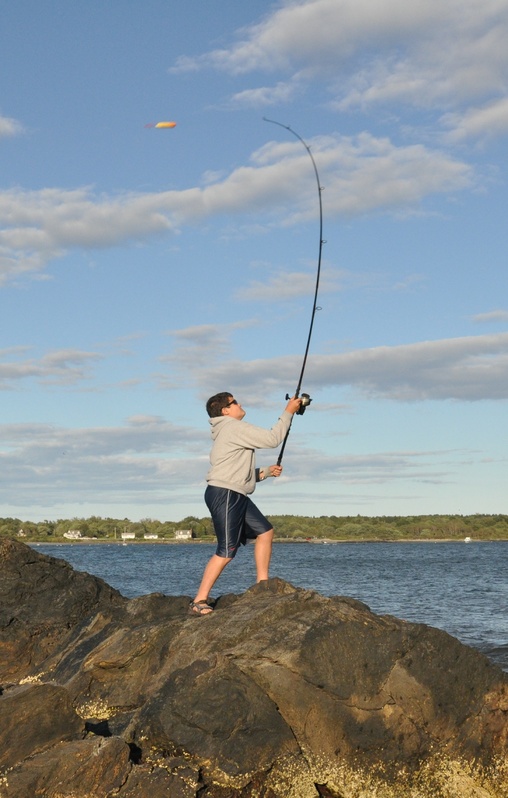Fall in Maine is any angler’s dream. As the nights get cooler, water temperatures drop and fish become more active. On inland lakes and streams, once reluctant trout and salmon start to reappear, feeding in the shallower waters, and in the Gulf of Maine the fall migration is set to begin.
Many fish species call the gulf home in the summer, but as the days get shorter and the water gets colder, a migratory response is triggered in many species of fish and they start to feed in anticipation of their journey south.
In some cases, they start to feed heavily, and oftentimes, within casting distance from shore.
Surf casting is one of the most enjoyable and least expensive ways to target striped bass and bluefish. It can be highly productive, and you have miles of scenic coastline to choose from.
“We may not be as busy with saltwater fishermen this time of year,” said Jennifer Johnson of Johnson’s Sporting Goods in Brunswick, “but the experienced saltwater fishermen know this is one of the best times of the year to go fishing.”
In the Atlantic, striped bass can be found from the St. Lawrence River in Canada south all the way to the St. John River in Florida. Most striped bass caught in Maine migrate from the Chesapeake Bay, although there is a strain of resident striped bass in the Kennebec River.
Bluefish can travel as far north as Nova Scotia, but generally are not found north of Maine. Bluefish spawn off the continental shelf east of the Carolinas, and make the round trip to New England waters each summer.
These migratory striped bass and bluefish are now feeding heavily, and can be found all along the shore of Maine’s southern coast, busting bait to the surface, chasing bait in the surf.
“Since the hurricane, we have definitely seen the fishing improve. The last couple of days, shore anglers have been catching big bluefish in the 34-35 inch range,” said Marco Lamothe of Saco Bay Tackle. Lamothe said there are reports of big stripers in the area as well, with some stripers in the 40-inch range.
During the hot summer months, surf anglers tend to have more luck at night. In the fall, however, these nocturnal hours are not as necessary.
“Low light is more important than the tide this time of year. Anglers are having success near dusk and dawn,” said Lamothe.
On the south coast, there are no shortages of areas to fish. Beaches that were packed just weeks ago are now largely vacant. Parking is no problem either, particularly near dawn or dusk.
“This time of year, it is very easy to find an area to fish, and access is very easy,” said Lamothe. “You can get away for 45 minutes or even a couple of hours.”
Anglers who are looking for bigger fish will have better luck with bait this time of year. Whole or chunked mackerel works well for larger fish, and for smaller fish, clams and sandworms have been doing the trick.
If you have never surf fished, getting started is relatively easy. Both Johnson’s and Saco Bay Tackle have introductory surf casting outfits for under $50. Saco Bay Tackle also rents rods.
If you do plan to go fishing, a little low tide scouting will serve you well. Visit a potential spot at dead low tide so you can see where there may be structure, and how the estuaries drain. Since you may be arriving pre-dawn or leaving after dark, this scouting visit will give you more familiarity with the area.
When I am casting lures or flies off the beach, I always bring a fanny pack with pliers, extra lures, terminal tackle, a headlamp, bug dope and a water bottle.
I wear good gripping shoes that make me feel a little more secure on rocks and ledges.
If I am fishing the surf with bait, in addition to the pack, I also bring a sand spike for my rod, and a portable chair to sit in. Like any type of fishing, there is no way to tell when that next strike may arrive, so it’s best to make yourself comfortable.
Before you go, visit a local tackle store to see what lures and baits are working. They will also be happy to help you with terminal tackle, or direct you to where people seem to be catching fish.
“Certain areas and particular baits can be better this time of year,” said Johnson. “We can get you set up so you have a better chance of catching fish.”
So even if it may seem a little too cool to go swimming, it certainly is still worthwhile to make that trip to the beach before the blues and stripers, like so many visitors to Maine, head south for the winter.
Mark Latti is the former public information officer for the Maine Department of Inland Fisheries and Wildlife, a Registered Maine Guide and a member of the New England Outdoor Writers Association. He can be reached at:
mlatti@gmail.com
Send questions/comments to the editors.



Success. Please wait for the page to reload. If the page does not reload within 5 seconds, please refresh the page.
Enter your email and password to access comments.
Hi, to comment on stories you must . This profile is in addition to your subscription and website login.
Already have a commenting profile? .
Invalid username/password.
Please check your email to confirm and complete your registration.
Only subscribers are eligible to post comments. Please subscribe or login first for digital access. Here’s why.
Use the form below to reset your password. When you've submitted your account email, we will send an email with a reset code.